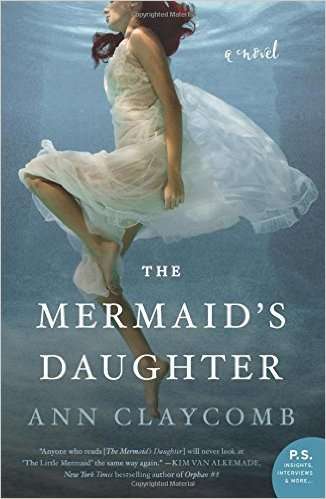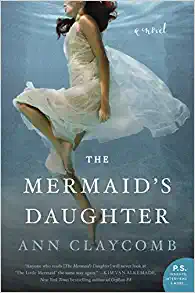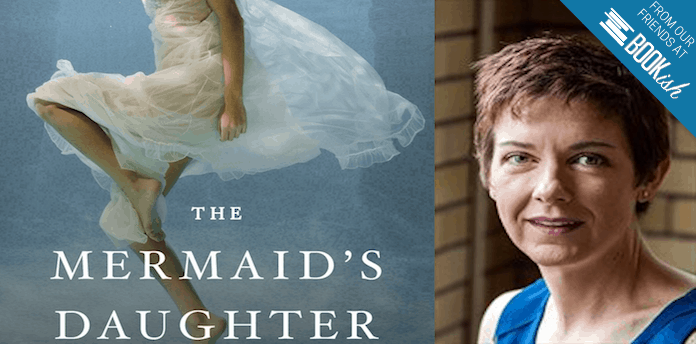The Mermaid's Daughter by Ann Claycomb
BookTrib is partnering with Bookish to bring you more great content, including this article from Ann Claycomb!
Fiction and creative nonfiction writer Ann Claycomb has become the master of the underwater life of mermaids since researching for her latest novel, The Mermaid’s Daughter. Below, she shares with Bookish her discoveries and the ultimate lure of the fictional creatures that live under the sea.
 Mermaids. What would you give to be part of their world? When studying mermaids, Ann Claycomb found their portrayals fascinating. They were either tranquil, pastel sunbathers or powerful, deadly sirens. Here, Ann Claycomb explores that dichotomy and shares how it inspired her latest novel, The Mermaid’s Daughter (William Morrow, March 7, 2017).
Mermaids. What would you give to be part of their world? When studying mermaids, Ann Claycomb found their portrayals fascinating. They were either tranquil, pastel sunbathers or powerful, deadly sirens. Here, Ann Claycomb explores that dichotomy and shares how it inspired her latest novel, The Mermaid’s Daughter (William Morrow, March 7, 2017).
When you write a book about mermaids, people buy you mermaid-themed gifts. You don’t need to receive many of these to identify the trends: pastel washes of color, a predominance of shimmer and turquoise, coyly-placed scallop shells and tails that are look too long or too fat or just weird. Last summer, beach shops featured a t-shirt that read: Always be yourself, unless you can be a mermaid. Then be a mermaid.
As the parent of a 7-year-old boy, I thought the mandate was to always be yourself, unless you can be Batman. I found it confusing when repurposed for mermaids. Batman is clearly a badass. Mermaids are—well, what are mermaids? The ones featured on sun-catchers and t-shirts are dreamy, abstracted creatures, sweetly pretty but not sexual. They swim in warm, sun-dappled water and spend a lot of time combing their hair. They appeal because they embody a fantastical extreme of a leisurely life in paradise. Forget sitting by the pool; why not imagine yourself immersed in a crystalline tropical sea, having solved the problem of how to hide your thighs in a bathing suit and enjoying the best hair day of your life.
But there are other mermaids, who swim in deeper, colder water. Their seas are turbulent, uncharted, leading down into black depths rather than up onto white sands. These are alien creatures, perhaps still beautiful, but dangerous too, and nothing we can aspire to be, any more than we can aspire to be dragons or tigers or stars. They embody not a blurred watercolor femininity but a more sinuous and shadowy one.
Let’s not forget that in most folklore mermaids lured human men to their death in the sea. Surely they must have felt a kind of scorn for the creatures who threw themselves foolishly to their deaths for a song only half-heard and little understood. And what did they want with men anyway, these mermaids? Not sex or romance, clearly. Did they just thrill to their own power as the bodies tumbled into the water? Or were the deaths accidental and faintly regrettable, noted and sighed over the way we might sigh over a groundhog that lumbers in front of our car?
We can’t know. That’s the lure of these mermaids—perhaps for sailors of old, but definitely for us now. We can’t know them, not how they think or feel or sound or even how they can stand to swim in cold water and never need the sun on their faces. We can’t know them and they don’t seem interested in knowing us. Hans Christian Andersen’s “Little Mermaid,” and Ariel, her technicolor sister, are remarkable in part because they are mermaids fascinated by humans. Go back and read the original story and you’ll see: The rest of her family isn’t frightened or cowed by humans. They just find us a bit of a yawn. Legs, you say? (“Walking around on those—what do you call ‘em? Oh, feet!”) Who needs them?
That’s why I wanted to take on Andersen’s tale (pun inevitable) in The Mermaid’s Daughter, because I always thought it hinted at the lives of one kind of mermaid—the one with the siren song—while claiming that its heroine was the other kind, the one who just wants a prince to love her and her pretty scallop-shell bra. I wanted to write some of the unknowability back into the story, to reclaim the Little Mermaid’s strangeness for her. That’s hubristic, I get that; the mermaids who don’t care about us certainly don’t care about our stories about them. But mermaids themselves are not, after all, my readers. I want the human readers of my book to experience the mermaids they can’t find in gift shops, both their power and their alien nature. I wanted to evoke the deep waters we can never plumb, the songs we can hear but never sing ourselves. I wanted to offer readers a glimpse of the truly mysterious and unknowable. I don’t know if I have, but it was a thrill to chase those mermaids through their depths.
Buy this Book!
Amazon




